(23.10.11) Mechanisms of Digestion and Absorption & Processing of Nutrients
1/28
There's no tags or description
Looks like no tags are added yet.
Name | Mastery | Learn | Test | Matching | Spaced |
|---|
No study sessions yet.
29 Terms
Describe the general processes of digestion and absorption.
Digestion break down ingested foods into their chemical building blocks
Only these molecules are small enough to be absorbed across wall of small intestine
Define Digestion
Catabolic process that breaks macromolecules down into monomers small enough for absorption
Intrinsic and accessory gland enzymes are involved in digestion
Enzymes carry out hydrolysis → whereby water is added to break chemical bonds
This type of chemical reaction typically occurs as nutrients are digested in the body.
Hydrolysis → refers to the enzymatic breakdown of large polymers into monomers while adding the parts of a water molecule to the broken bonds
T/F: Most digestion occurs in the stomach
→ FALSE
Most digestion occurs in the SMALL INTESTINE, and is accomplished by enzymes secreted to the lumen that hydrolyze larger molecules into monomers
Absorption of nutrients primarily occurs in the __________.
→ Small intestine
Define Absorption
Process of moving substances from lumen of gut into body
Tight junctions ensure molecules must pass through epithelial cell rather than between them
Lipid molecules can be absorbed passively through membrane, but polar molecules are absorbed by active transport
Most nutrients are absorbed before chyme reaches ileum
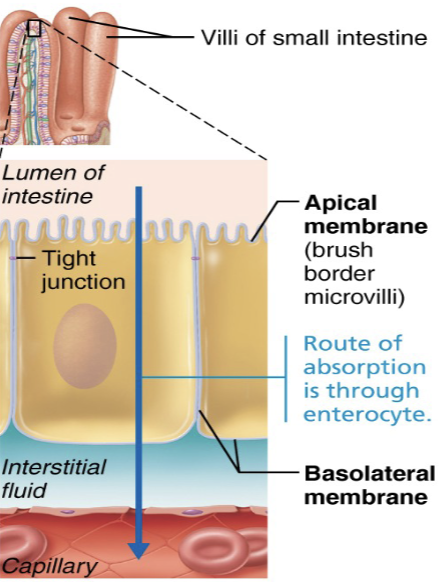
List the order of Absorption of Molecules in the Intestine
ENTERING epithelial cells across the apical membrane
In the lumen
Across the basolateral face of the interstitial fluid
DIFFUSE into capillaries or lacteals
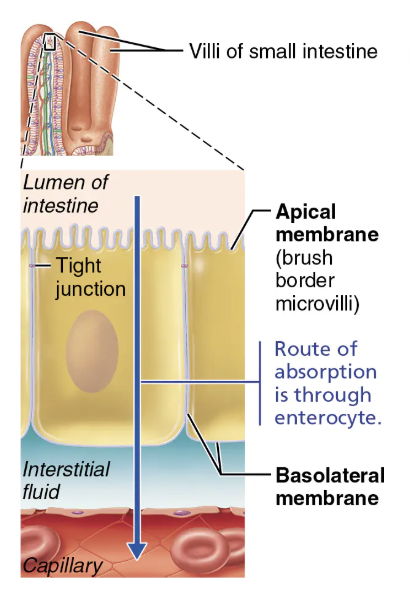
How are carbohydrates absorbed?
ONLY monosaccharides can be absorbed
List the START & END Products of Carbohydrate Digestion
BEGINS with the mouth as salivary amylase splits Polysaccharides into oligosaccharides
Starch
Glycogen
Intestine, pancreatic amylase breaks down Polysaccharides → oligosaccharides and disaccharides
Lactose
Maltose
Sucrose
Brush border enzymes break oligo- and disaccharides → Monosaccharides
Glucose
Frutose
Galactose
Monosaccharides exit acrosss the basolateral membrane by facilitated difussion
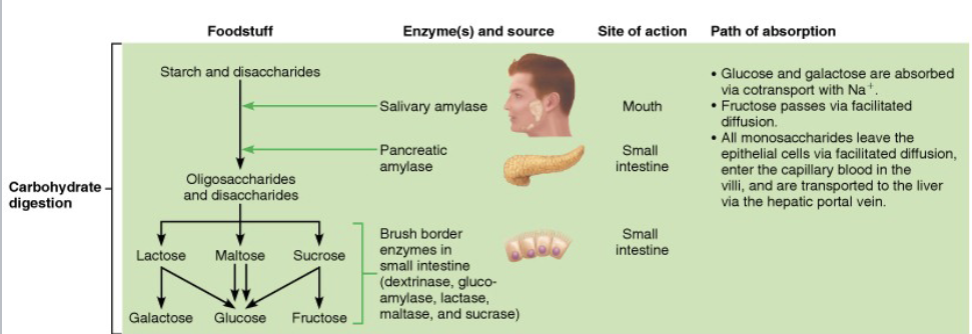
SUMMARY Carbohydrate digestion and absorption in the small intestine
Pancreatic amylase breaks down starch and glycogen (Polysaccharides) → oligosaccharides and disaccharides
Brush border enzymes break oligosaccharides and disaccharides → monosaccharides
Monosaccharides (glucose and galactose) are cotransported across the apical membrane of the absorptive epithelial cell
This active transport uses the Na+ concentration gradient established by the Na+-K+ ATPase (pump) in the basolateral membrane
Monosaccharides exit across the basolateral membrane by facilitated diffusion and enter the capillary via intercellular clefts
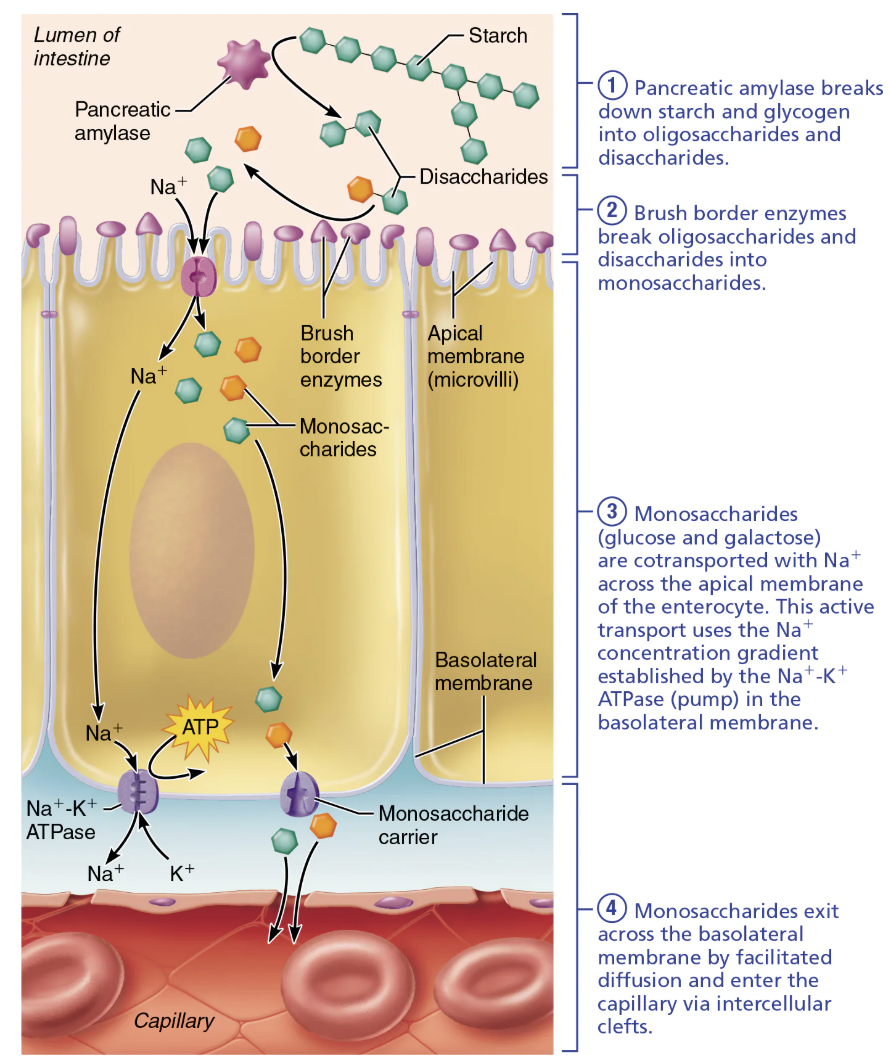
Explain Effect and Cause of Lactose intolerance
EFFECT
Any lactose eaten remains undigested and creates an osmotic gradient in intestine that prevents water from being absorbed → resulting in diarrhea
CAUSE
Deficient amounts of lactase and cannot consume lactose
List the START & END Products of Protein Digestion
BEGINS in stomach when pepsinogen is converted to pepsin (@ pH 1.5-2.5)
Becomes inactive in high pH of duodenum
Large polypeptides
Small intestine, pancreatic protease break down Proteins and protein fragments into smaller pieces and some individual amino acids
Small polypeptides
Small peptides
Brush border enzymes break oligo- and dipeptides into amino acids
Amino acids (some dipeptides and tripeptides)
Amino acids are co-transpoted across the apical membrane of the absorptive epithelial cell
Amino acids exit across the basolateral membrane via facilitated diffusion
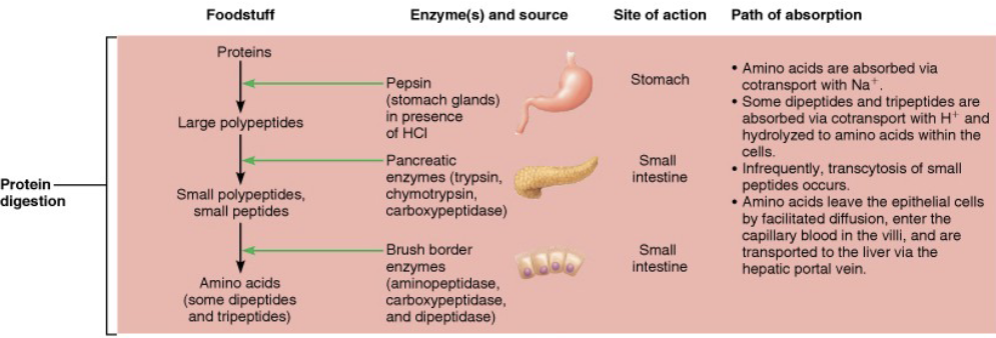
How is Protein digestion different from other macromolecule digestion?
Proteins digested into amino acids in the GI tract include not only dietary proteins but also enzyme proteins secreted into the GI tract lumen
Which of the following digestive processes could be affected by a patient's taking a large amount of antacids?
→ Protein digestion
Protein digestion is partially accomplished by pepsin, an enzyme that works best in a pH range of 1.5 to 2.5
Which chemical activates the transformation of trypsinogen to trypsin?
Enteropeptidase → a protein produced by and bound to the membranes of intestinal cells. Contact with this protein converts trypsinogen to trypsin, the active form of the enzyme
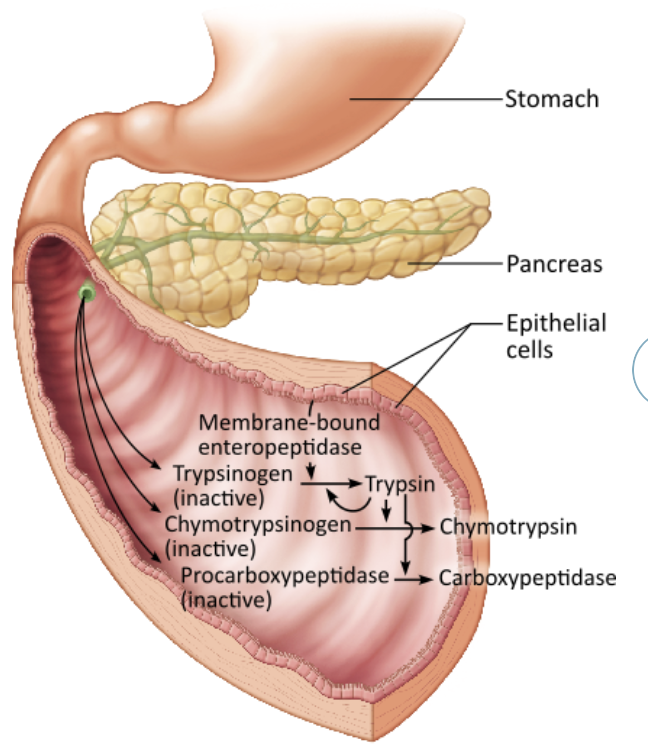
SUMMARY Protein Digestion and absorption in the small intestine
Pancreatic proteases break down proteins and protein fragments into smaller pieces and some individual amino acids
Trypsin & Chymotrypsin cleave protein into smaller peptides
Carboxypeptidase takes off the amino acid at a time from end
Brush border enzymes break protein fragments into amino acids
Amino-peptidases, Carboxypeptidases, and Dipeptidases break oligopeptides and dipeptides into amino acids
Amino acids are cotransported across the apical membrane of the absorptive epithelial cell
This active transport uses the Na+ concentration gradient established by the Na+-K+ ATPase (pump) in the basolateral membrane
Amnio acids exit across the basolateral membrane via facilaited diffusion and enter the capillary via intercellular clefts
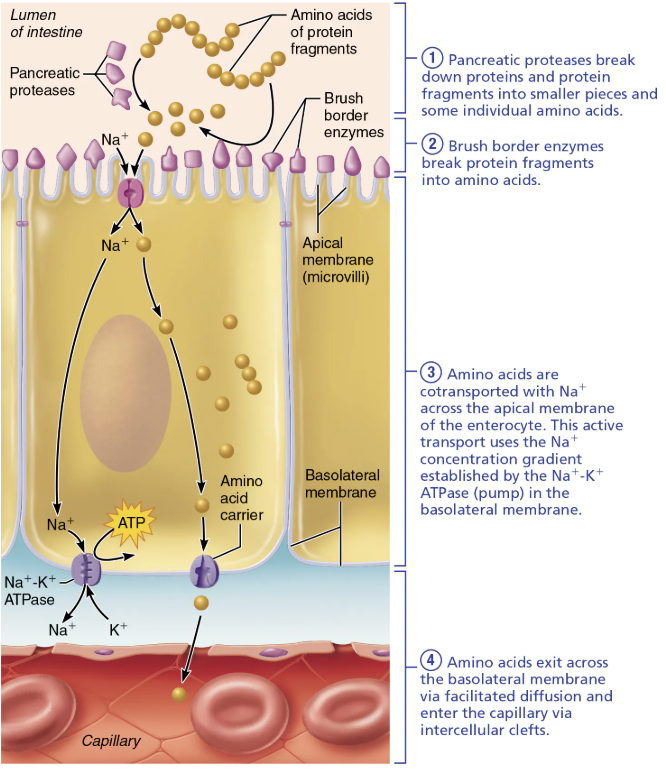
Explain Cause and Effectof Unabsorbed Protein
CAUSE
Intact proteins are taken up by intestinal epithelial cells by endocytosis and are released into body
Most common in newborn infants because of immaturity of their intestinal mucosa
EFFECT
May result in food allergies as immune system “sees” intact proteins as antigenic and mounts an attack → Allergies usually disappear as mucosa matures
List the START & END Products of Lipid Digestion
BEGINS unemulsified triglycerides
Need pre-treatment with bile salts (from liver) that break large fat globules into smaller ones
Emulsification → triglycerides and their breadown products are insoluble in wate
Pancreatic lipases hydrolyze triglycerides, yielding monoglycerides and free fatty acids
Monoglycerides and fatty acids combine with bile salts and lecithin to form micelles @ the plasma membrane, fatty acids and monoglycerides diffuse into epithelial cells of the mucosa
Within the epithelial cells, fatty acids and monoglycerides are converted back into triglycerides, then combined with lecithin, cholesterol, and other lipids, to form Chylomicrons → which are exocytosed to the interstitial space, and taken into lacteals for transport
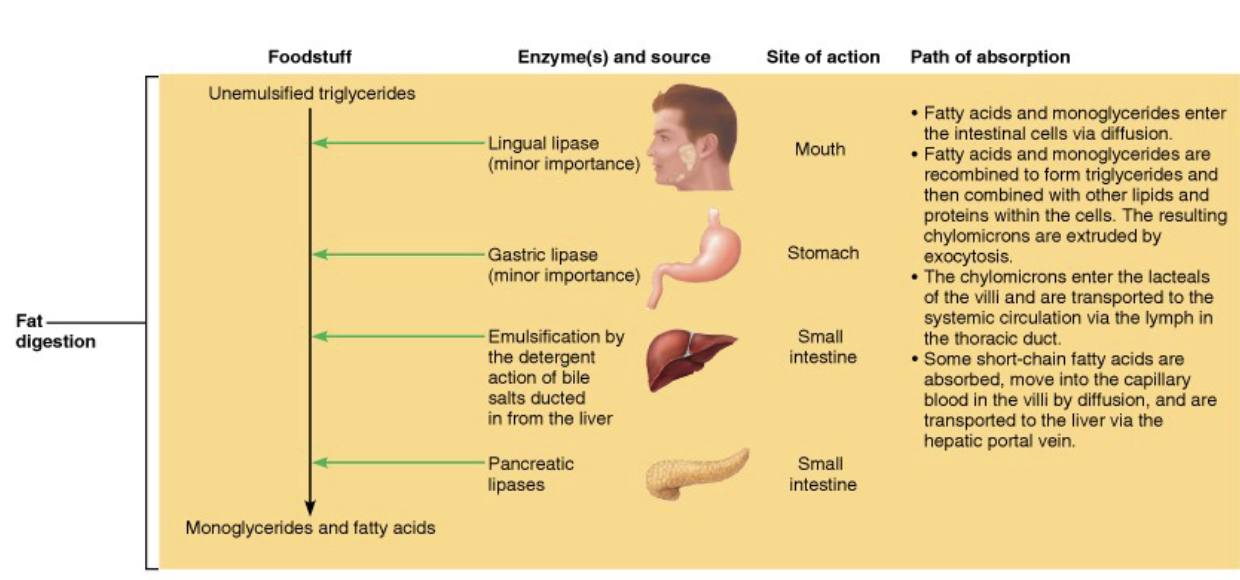
SUMMARY Lipids Digestion and absorption in the small intestine
Emulsification → Bile salts in the duodénum break fat globules into smaller fat droplets (increasing the surface area avialable to lipase enzyme)
Digestion → Pancreatic lipases hydrolyze triglycerides, yielding monoglycerides and free fatty acids
Micelle formation → Free fatty acids and monoglycerides assemble with bile salts, forming micelles
Micelles ferry their contents to enterocytes
Diffusion → Fatty acids and monoglycerides diffuse from micelles into enterocytes
Chylomicron formation → Fatty acids and monoglycerides are recombined and packaged with other fatty substances and proteins to form chylomicrons
Chylomicron transport → Chylomicrons are extruded from enterocytes by exocytosis, enter lacteals and are carried away from the intestine in lymph
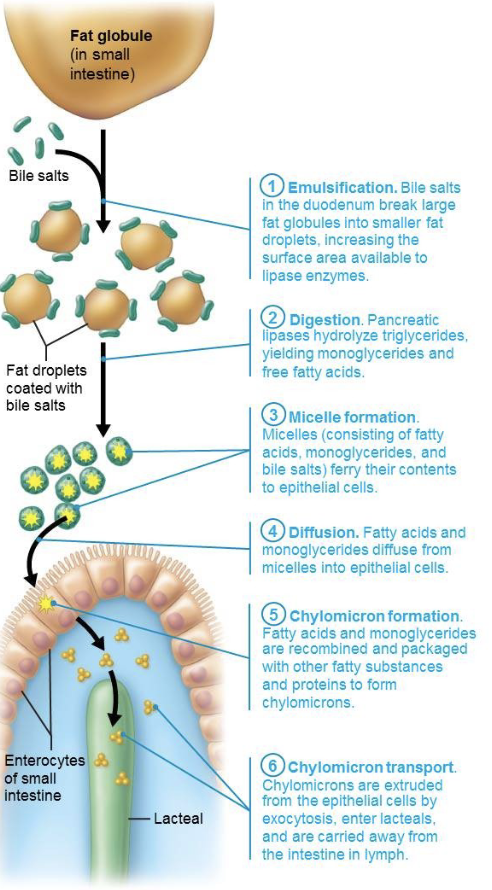
SUMMARY by which Breakdown Products of Foodstuffs are Absorbed (TRANSPORTED) in the Small Intestine
Carbohydrates
Salivary amylase digest polysaccharides (starch) in the mouth
Pancreatic amylase digest polysaccharides in the small intestine
Fructose molecules → are absorbed by facilitated diffusion into intestinal epithelial cells
Glucose and galactose → are shuttled via secondary active transport with Na+ into intestinal epithelial cells
Proteins
Pepsin digests proteins in the stomach
Trypsin and Chymotrypsin digests proteins in the small intestine
Amino acids → are shuttled via secondary active transport with Na+ into intestinal epithelial cells
Lipase
Gastric lipase digests lipids in the stomach
Pancreatic lipase digests lipase in the small intestine
Fatty acid and glycerides → must combine with bile salts to form → micelle → are absorbed by simple diffusion into intestinal epithelial cells
Where are the enzymes for digestion of disaccharides and small polypeptides located?
→ Brush border
Vitamin Absorption in the Small Intestine
Fat-soluble vitamins (A, D, E, and K) are carried by micelle; diffuse into absorptive cells
Water-soluble vitamins (C and B) are absorbed by diffusion or by passive or active transporters
Vitamin B12 (large, charged molecule) bind with intrinsic factor and is absorbed by endocytosis
How are vitamins A, D, E, and K absorbed by the body?
→ by being incorporated into micelles
Fat-soluble vitamins are incorporated into micelles when fats are present.
Vitamin Absorption in the Large Intestine
Vitamin K and B vitamins bacterial metabolism are absorbed
Electrolytes Absorption
Most ions are transported activity along length of small intestine
Iron and calcium are absorbed in duodenum
Na+ absorption is coupled with active absorption of glucose and amino acids
Usually amount in intestine is amount absorbed
Explain how Iron & Calcium Absorption is Related to Need
Ionic iron is stored in mucosal cells with ferritin
When needed, transported in blood by transferrin
Ca2+ absorption is regulated by vitamin D and parathyroid hormone (PTH)
Water Absorption
9 L water → most from GI tract secretions, enter small intestine
95% is absorbed in the small intestine by osmosis
Most of rest is absorbed in large intestine
Net osmosis occurs if concentration gradient is established by active transport of solutes
Water uptake is coupled with solute uptake
Explain Cause and Effect of Malabsorption
CAUSE
ANYTHING that interferes with delivery of bile or pancreatic juice
EFFECT
Damaged intestinal mucosa (EX: bacterial infection or some antibiotics)
Explain Cause, Effect, and Treatment of Gluten-Sensitive Enteropathy
CAUSE
Common malabsorption disease
Immune reaction to gluten
EFFECT
Gluten causes immune cell damage to intestinal vili and brush border
TREATMENT
Eliminate gluten from diet